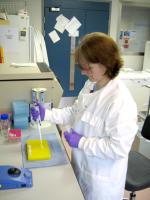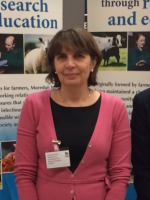
Work Package Livestock production, health, welfare and disease control
Introduction
Endemic infectious diseases of livestock in Scotland result in substantial economic losses to Scottish farming and are a serious concern for animal welfare. Reducing the impact of livestock disease will improve the efficiency and sustainability of Scottish and UK farming and strengthen the viability of rural communities. This benefits the wider public through increased food security and safety. Disease control can be improved through the implementation of robust diagnostic tests and vaccines and by increasing our understanding of the dynamics of disease transmission. However, for many important diseases of livestock effective control tools are lacking and there is a need for improved understanding of disease biology that would allow such tools to be developed. The research in this programme will address this issue by providing new information that can be translated into practical and affordable diagnostic tests and vaccines for use by farmers, veterinarians and other stakeholders to reduce the societal impact of these important enzootic diseases.
Aim of Research
Disease mechanisms: The aim of this work is to provide increased understanding of how pathogens (viruses, bacteria and parasites) interact with their host to cause disease. This new knowledge will underpin the development of next-generation control strategies for a range of infectious diseases of importance to livestock production both nationally and internationally. A broad range of questions will be addressed, with a particular focus on the role of the livestock host immune system in the disease process, the identification of new diagnostic markers of disease and the mechanisms involved in pathogen spread within the host and transmission between hosts. The key driver for this research is the current lack of reliable control methods for the diseases under study, which result in substantial economic losses to Scottish and UK farming and are a serious concern for animal welfare. The knowledge gained will be directly exploited in other parts of the Scottish Government-funded research programme.
Progress
In this year of the research programme, work continued to examine the mechanisms involved in livestock disease and to build further on our success in translating the knowledge gained into new control strategies such as vaccines and diagnostic tests. Further advances were made in the development of vaccines against enzootic abortion, Johne’s disease, mastitis, sheep scab and nematode infection in sheep, with some of the candidate vaccines being evaluated for commercial production. An improved platform for diagnosis of bovine respiratory disease was adopted and implemented for use by Moredun and SRUC Vet Services. This will be valuable for supporting future surveillance and disease investigations. The sheep scab ELISA test in now being offered by both Biobest Laboratories Ltd and the Welsh Veterinary Science Centre and is playing a crucial role in several disease control programmes throughout GB. Novel systems were developed for culturing and characterising Cryptosporidium in vitro and for generating new approaches to controlling chlamydial infections in sheep. Finally new knowledge was gained in the understanding of the basis of Campylobacter infection, and BRD. Some of this work has directly informed new projects to be pursued in the next RESAS Strategic Research Programme.
As in many areas of the Strategic Research Programme, some of the studies planned on Disease Mechanisms in Year 5 were impacted by the restrictions on travel and working imposed due to the COVID-19 pandemic. Nevertheless, progress was made in a number of areas, including improved understanding of immune responses in cattle with Johne’s Disease and in sheep with mastitis and advances in understanding the interaction between Campylobacter and other gut bacteria that impact on disease. In addition, progress was made to optimise the production of a vaccine targeting ovine enzootic abortion and new knowledge was gained in understanding the role of host factors such as weight and immune status in the response to a vaccine for nematode infection in sheep. All of this new knowledge will be used to inform the development of new disease control strategies in Year 6 of the programme.
In year 4 of this research programme, studies continued to increase our understanding of basic mechanisms involved in the interaction of livestock pathogens (viruses, bacteria or parasites) and their host. This included studies examining the efficacy of novel vaccines targeting a number of important diseases, including ovine enzootic abortion, ovine mastitis and parasitic gastroenteritis. In parallel, important advances were made to methods used for studying the biology of livestock pathogens in the laboratory. Some highlights include the development of a system for studying Cryptosporidium infection in cultured gut cells from cattle and methods for experimentally manipulating the expression of specific genes in Psoroptes ovis, the cause of sheep scab. Other work advanced our understanding of jaagsiekte sheep retrovirus replication in cell lines and immune responses to Pasteurella multocida in cultured lung tissue. Collectively, these studies have provided many advances in our understanding of these economically damaging diseases and the knowledge gained is crucial for the design of effective control strategies to combat them.
In year 3 of this research programme, research continued to examine the mechanisms underlying livestock diseases, with a special focus on the identification and characterisation of diagnostic targets and candidate vaccine antigens for specific diseases. Particular success was achieved in identifying target vaccine antigens in enzootic abortion (the major cause of abortion in sheep in the UK) and sheep scab. A multiplex diagnostic assay for identifying pathogens involved in bovine respiratory disease complex was also developed. In addition, other work utilised a number of disease models to increase our understanding of the processes occurring during infection. This information will inform the design of control strategies in future years.
In year 2 of this research programme, research continued into improving understanding of the interactions between pathogen (viruses, bacteria or parasites) and the livestock host that lead to disease in farmed ruminants. This information will underpin future control strategies for the diseases in question. This is exemplified by the work that has identified novel diagnostic approaches for investigating Bovine Respiratory Disease outbreaks. The tools developed are now being used by veterinary diagnostics services to diagnose disease in the field. Other Objectives in this programme are at an earlier stage but show great promise for leading to improved vaccines and diagnostic tests.
In year 1 of this research program, a diverse range of research activities was performed that has led to numerous advances in understanding the mechanisms underlying infectious diseases of livestock. One important area of work is the creation of experimental model systems that allow the study of pathogens (viruses, bacteria or parasites) and the livestock host in the laboratory, using tissue extracts or purified cells. Such systems have been established for studying bovine respiratory disease, bovine cryptosporidiosis and ovine pulmonary adenocarcinoma and are providing valuable information on disease processes without the need to use live animals. Other studies have examined gene expression in bacteria involved in causing food poisoning, which is helping to provide a detailed picture of how these pathogens interact with their hosts and may lead to improved tests for identifying contaminated food and will inform future strategies for treatment and control.
Future Activities
Many areas of work performed in RD2.2.3 will inform research projects in the next RESAS Programme. For example, studies on advanced culture systems have informed planned work on tissue models for BRD and transwell and organoid systems for several pathogens to be performed in MRI-A2-1. These include wild-type and fluorescently–tagged jaagsiekte sheep retrovirus and wild-type, knockout mutants (generated in the previous programme) and a mutant library of Mycobacterium avium subspecies paratuberculosis. The work on Cryptosporidium conducted in RD2.2.3 will inform work that will be conducted in MRI-A2-9, where the competencies of different wildlife host will be evaluated for C. parvum. Vaccine delivery methods, based on information gleaned from RD 2.2.3, will be refined using novel laboratory-based experimental systems in the project MRI-A2-1 and will be put into practice in MRI-A2-7, MRI-A2-8 and in MRI-A2-9 to control multiple pathogens of livestock, including for tick-borne diseases, ovine chlamydiosis and sheep scab. Vaccine development against several parasitic nematode species in sheep will continue in MRI-A2-6, which will also feature the refinement of vaccines for use against parasitic helminths in cattle. The knowledge gained from work in RD2.2.3 on mastitis will inform future work in MRI-A2-2 involving a large scale observational study to characterise mastitis pathogens and susceptibility of individual sheep to disease.
Selected Outputs
Animated video: Stop the creeps on sheep:
https://www.moredun.org.uk/foundation/outreach/animation-series
Webinars on Iceberg Diseases including MAP and OPA.
https://www.moredun.org.uk/news/moredun-nsa-and-sruc-iceberg-diseases-webinar
SEFARI – Blog on Iceberg diseases https://sefari.scot/blog/2020/05/18/nsa-and-moredun-iceberg-disease-webinars-the-problem-of-subclinical-disease-lurking
SEFARI – Soil leaflet: https://sefari.scot/sites/default/files/documents/SEFARI_Soil_Booklet.pdf
Battle of the bugs (reported in KE6 in Y1) https://vimeo.com/221440637
The bile salt sodium taurocholate induces Campylobacter jejuni outer membrane vesicle production and increases OMV‐associated proteolytic activity (reported in O10.3ii in Y1) https://doi.org/10.1111/cmi.12814
Bovine cryptosporidiosis: impact, host-parasite interaction and control strategies. https://veterinaryresearch.biomedcentral.com/articles/10.1186/s13567-017-0447-0
A recombinant subunit vaccine for the control of ovine psoroptic mange (sheep scab). https://veterinaryresearch.biomedcentral.com/articles/10.1186/s13567-016-0315-3
The rational simplification of a recombinant cocktail vaccine to control the parasitic nematode Teladorsagia circumcincta https://doi.org/10.1016/j.ijpara.2018.10.006
Animation on Cryptosporidium “Control the Crypto”
https://www.moredun.org.uk/foundation/outreach/animation-series
A One Health approach to tackle cryptosporidiosis.
https://www.cell.com/action/showPdf?pii=S1471-4922%2820%2930009-X
Transcriptional response of ovine lung to infection with jaagsiekte sheep retrovirus.
https://jvi.asm.org/content/93/21/e00876-19
Control of paratuberculosis: who, why and how. A review of 48 countries.
https://bmcvetres.biomedcentral.com/articles/10.1186/s12917-019-1943-4
https://sfamjournals.onlinelibrary.wiley.com/doi/full/10.1111/1751-7915.13518
Shaw, H.J., Innes, E.A., Morrison, L.J., Katzer, F., Wells, B (2020) Long-term production effects of clinical cryptosporidiosis in neonatal calves. International Journal of Parasitology, 50, 371-376 https://dx.doi.org/10.1016%2Fj.ijpara.2020.03.002
Caspe S.G., Livingstone, M., Frew, D., Aitchison, K., Wattegedera, S.R., Entrican, G., Palarea-Albaladejo, J., McNeilly, T.N., Milne, E., Sargison, N.D., Chianini,F., Longbottom D. (2020). The 1B vaccine strain of Chlamydia abortus produces placental pathology indistinguishable from a wild type infection.
https://journals.plos.org/plosone/article?id=10.1371/journal.pone.0242526
The Moredun Foundation News Sheet Vol. 7, No. 8, November 2020 – Moredun’s Centenary Science Stories Volume 1: Enzootic Abortion of Ewes, pp. 13-15.
Innes, E., Longbottom, D., Livingstone, M., Campbell, S. Prevention and control of ovine abortion: Test don’t guess. Veterinary Ireland Journal, July 2020. http://www.veterinaryirelandjournal.com/focus/176-prevention-and-control-of-ovine-abortion-test-don-t-guess
Cortes A, Wills J, Su X, Hewitt R, Robertson J, Scotti R, Price D, Bartley Y, McNeilly T, Krause L, Powell J, Nisbet AJ, Cantacessi C. 2020. Infection with the sheep gastrointestinal nematode Teladorsagia circumcincta increases luminal pathobionts. Microbiome 8(1):60. https://doi:10.1186/s40168-020-00818-9.
Cortes A, Bartley D, Nisbet AJ, Cantacessi C. 2020. Helminths, hosts, and their microbiota: new avenues for managing gastrointestinal helminthiases in ruminants. Expert Reviews on Anti-infective Therapy https://doi.org/10.1080/14787210.2020.1782188
Vaccine-induced time- and age-dependent mucosal immunity to gastrointestinal parasite infection
Genetic diversity and shedding profiles for Cryptosporidium parvum in adult cattle and their calves.
Intramammary immunisation provides short term protection against Mannheimia heamolytica mastitis in sheep (2021) Riccardo Tassi, Martina Schiavo, Joel Filipe, Helen Todd, David Ewing and Keith T Ballingall. https://doi.org/10.3389/fvets.2021.659803.
Burgess STG, Nunn F, Bartley K, Frew D, McLean K, Inglis NF, McGeachy K, Taliansky ME, Love AJ, Nisbet AJ. Psoroptes ovis-Early Immunoreactive Protein (Pso-EIP-1) a novel diagnostic antigen for sheep scab. Parasite Immunol. 2020 Dec;42(12):e12788. doi: 10.1111/pim.12788. Epub 2020 Sep 14. PMID: 32854149.












